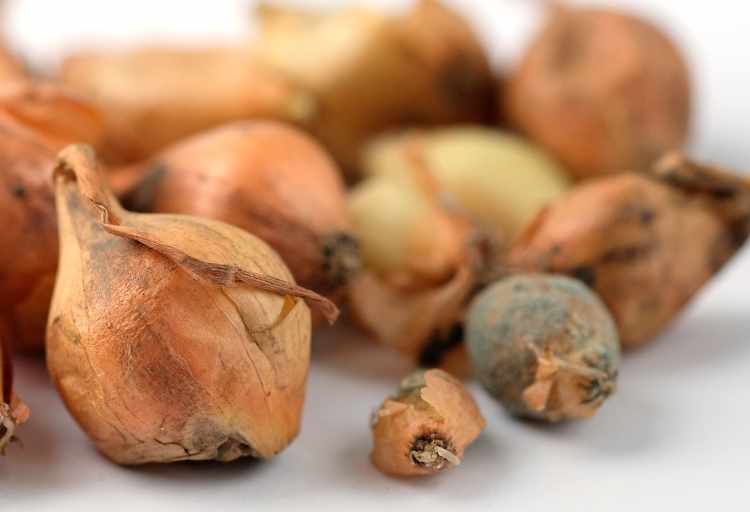What Is Black Mold On An Onion
Do you ever wonder what that dark, fuzzy substance is on your onion? Well, it’s none other than black mold. Black mold on onions is a common issue that can affect their quality and safety. Understanding how black mold forms and its impact on onions is crucial for proper storage and handling techniques.
In this article, we will explore the causes of black mold on onions, its formation process, and the effects it has on both the taste and safety of these versatile vegetables. Additionally, we will provide tips on preventing black mold from developing on your onions in the first place.
So, if you’re curious about this mysterious substance and want to ensure the longevity of your onion supply, keep reading to learn all about black mold on onions.

What Is Black Mold On An Onion?
You might be wondering what causes black mold to grow on your onions. Well, understanding the health risks and cleaning methods can help you deal with this issue effectively.
Black mold on onions is caused by a fungus called Aspergillus niger. This fungus thrives in damp environments, so if your onions are stored in a moist or humid area, they’re more likely to develop black mold.
Now, when it comes to health risks, it’s important to note that consuming onions with black mold can be harmful.
The spores produced by the mold can cause respiratory problems, allergies, and even infections in individuals with weakened immune systems. Therefore, it’s crucial to check your onions for signs of black mold before using them.
To clean onions affected by black mold, simply discard any visibly contaminated layers and rinse the remaining layers thoroughly under running water. This should remove most of the spores and make the onion safe to consume.
However, if the black mold has penetrated deep into the onion or if you have any doubts about its safety, it’s best to err on the side of caution and discard it entirely.
Understanding why black mold grows on onions and how to properly clean them is essential for maintaining good health and avoiding potential risks associated with the consumption of contaminated produce.
Causes and Formation of Black Mold on Onions
Imagine the creeping dread that overcomes you when you notice a dark, fuzzy growth appearing on this otherwise humble kitchen staple.
Black mold on onions isn’t only unappetizing but also poses potential health risks. Understanding the causes and formation of black mold on onions can help you prevent its occurrence in your kitchen.
Here are three key factors that contribute to the formation of black mold on onions:
- Moisture: Excess moisture, like high humidity or improper storage conditions, creates an ideal environment for mold growth.
- Poor ventilation: Lack of proper air circulation can result in stagnant air around the onions, promoting mold development.
- Contamination: Onions can get contaminated with mold spores during harvesting, transportation, or storage.
The presence of black mold on onions shouldn’t be taken lightly as it may lead to respiratory issues and allergic reactions if consumed. To minimize the risk, ensure proper onion storage in a cool and dry place and discard any visibly affected ones promptly.
Impact of Black Mold on Onion Quality and Safety
Ensure the safety and quality of your onions by understanding how the presence of black mold can impact them.
Black mold on onions can pose serious health hazards if consumed. It produces mycotoxins, which are toxic substances that can cause allergic reactions, respiratory problems, and even liver damage in some cases.
Consuming onions with black mold can lead to food poisoning symptoms like nausea, vomiting, and diarrhea. To prevent black mold formation on your onions, make sure to store them in a cool and dry place with good ventilation.
Avoid placing them near damp areas or other fruits and vegetables that may promote moisture buildup.
Regularly inspect your onions for any signs of black mold growth and discard any affected ones immediately to maintain the safety and quality of your produce.
Preventing Black Mold on Onions
Keep your onions in a well-ventilated area to prevent the formation of harmful mold. Proper prevention techniques and effective storage methods can help you avoid black mold on your onions.
Firstly, ensure that your onions are stored in a cool, dry place with good air circulation. This will discourage the growth of mold and bacteria. Avoid storing onions near other fruits or vegetables as they release gases that can accelerate spoilage.
Additionally, inspect your onions regularly for any signs of decay or damage and remove any affected ones immediately to prevent the spread of mold.
Keeping your onions at an optimal temperature of around 45 to 55 degrees Fahrenheit can also help prolong their shelf life and minimize the risk of black mold formation.
By following these simple steps, you can ensure that your onions stay fresh and free from harmful black mold.
Proper Storage and Handling Techniques for Onions
Storing and handling onions properly is crucial for maintaining their freshness and quality. To ensure that your onions stay mold-free, it’s important to follow proper storage and handling techniques.
Firstly, find a cool, dry place to store your onions. This could be a pantry or a cellar with good ventilation. Avoid storing them near potatoes, as the moisture from the potatoes can cause onions to spoil faster.
Additionally, make sure to handle the onions gently to prevent bruising or damage. When you bring them home from the grocery store, remove any plastic bags or packaging and place them in a breathable container such as a mesh bag or an open basket. This will allow air circulation and help prevent moisture buildup that can lead to mold growth.
By following these simple steps, you can ensure that your onions stay fresh and mold-free for longer periods of time.
Identifying and Removing Black Mold on Onions
To keep your onions in top-notch condition and maintain their delicious taste, it’s important to quickly spot and eliminate any concerning growth that may occur. One common issue you may come across is black mold on onions.
Identifying black mold is relatively easy – simply look for dark, fuzzy spots or patches on the onion’s outer layer. If you notice any signs of black mold, it’s crucial to remove it promptly to prevent further contamination.
Start by carefully cutting off the affected area, making sure not to spread the spores. Dispose of the moldy portion immediately and wash your hands thoroughly afterward. It’s also essential to sanitize any utensils or surfaces that came into contact with the moldy onion to avoid cross-contamination.
By taking these steps, you can ensure your onions stay fresh and free from harmful mold.
Common Misconceptions and Myths about Black Mold on Onions
Now that you know how to identify and remove black mold on onions, let’s dive into some common misconceptions and myths surrounding this issue. It’s important to debunk these false beliefs to ensure you take the necessary steps to protect yourself from any potential health risks.
One common myth is that black mold on onions is harmless and can simply be cut off. However, this isn’t true as the spores of black mold can still contaminate the rest of the onion, leading to potential illness if consumed.
Another misconception is that cooking or boiling onions will kill the mold and make them safe to eat. Unfortunately, heat doesn’t destroy all types of molds and their toxins. Therefore, it’s crucial to discard any onions with black mold completely instead of trying to salvage them through cooking methods.
By understanding these myths, you can better safeguard your health when dealing with black mold on onions.
Conclusion
In conclusion, you now have a better understanding of black mold on onions. By knowing the causes and formation of this mold, as well as its impact on onion quality and safety, you can take the necessary steps to prevent it.
Proper storage and handling techniques are crucial in keeping your onions mold-free. Remember to identify and remove any black mold promptly. Don’t fall for common misconceptions or myths surrounding black mold on onions.
Stay informed to ensure the freshness and safety of your onions.
Contents
- What Is Black Mold On An Onion?
- Causes and Formation of Black Mold on Onions
- Impact of Black Mold on Onion Quality and Safety
- Preventing Black Mold on Onions
- Proper Storage and Handling Techniques for Onions
- Identifying and Removing Black Mold on Onions
- Common Misconceptions and Myths about Black Mold on Onions
- Conclusion
